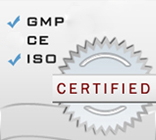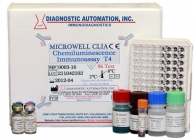
ELISA Kits
- • Anemia ELISA kits
- • Allergy ELISA kits
- • Autoimmune Disease kits
- • Bone Metabolism ELISA kits
- • Blood bank ELISA kits
- • Cancer ELISA kits
- • Cardiac Markers ELISA kits
- • Diabetes Assays ELISA kits
- • Drug test ELISA kits
- • Fertility ELISA kits
- • Food ELISA kits
- • Infectious Disease ELISA kits
- • Other ELISA Kits
- • Parasitology ELISA kits
- • Steroid ELISA kits
- • Thyroid ELISA kits
Rapid Tests
- • Allergy Rapid tests
- • Bone Metabolism
- • Cancer Rapid tests
- • Cardiac markers Rapid tests
- • Drug Tests
- • Fertility Rapid tests
- • Hepatitis Panel
- • Infectious Disease & other tests
- • Other
- • Ovulation Rapid tests
- • Pregnancy tests
- • Urine Reagent Strips tests
IFA Kits
Chemiluminescence Immuno Assays
- • Allergy Assays
- • Autoimmune Thyroid Assays
- • Cardio-Vascular Monitoring
- • Diabetes Assays
- • Fertility Assays
- • Growth Deficiency
- • Infectious Disease Assays
- • Others
- • Steroid Assays
- • Thyroid Assays
- • Tumor Marker Assays
Serology Tests
- • ASO (Anti-Streptolysin-O)
- • CRP (C-Reactive Protein)
- • Mono (Infectious Mononucleosis)
- • RF (Rheumatoid Factor)
- • RPR (Rapid Plasma Reagin)
- • SLE (Systemic Lupus Erythematosus)
Instrumentation



T3 CLIA kits - (Chemiluminescence Immuno Assay)
| Name |
T3 CLIA kits - (Chemiluminescence Immuno Assay) |
|---|---|
| Category Name | Thyroid Assays |
| Test | 96 |
 |
.jpg&w=195&h=140) |
 |
T3 CLIA kits - (Chemiluminescence Immuno Assay) description:
Chemiluminescence Immunoassay (CLIA) detection using Microplate luminometers provides a
sensitive, high throughput, and economical alternative to conventional colorimetric methodologies, such as Enzyme-linked immunosorbent assays (ELISA). ELISA employs a label enzyme and a colorimetric substrate to produce an amplified signal for antigen, haptens or antibody quantitation. This technique has been well established and considered as the technology of choice for a wide variety of applications in diagnostics, research, food testing, process quality assurance and quality control, and environmental testing. The most commonly used ELISA is based on colorimetric reactions of chromogenic substrates, (such as TMB) and label enzymes. Recently, a chemiluminescent immunoassay has been shown to be more sensitive than the conventional colorimetric method(s), and does not require long incubations or the addition of stopping reagents, as is the case in some colorimetric assays. Among various enzyme assays that employ light-emitting reactions, one of the most successful assays is the enhanced chemiluminescent immunoassay involving a horseradish peroxidase (HRP) labeled antibody or antigen and a mixture of chemiluminescent substrate, hydrogen peroxide, and enhancers. The CLIA Kits are designed to detect glow-based chemiluminescent reactions. The kits provide a broader dynamic assay range, superior low-end sensitivity, and a faster protocol than the conventional colorimetric methods. The series of the kits covers Thyroid panals, such as T3, T4, TSH, Hormone panals, such as hCG, LH, FSH, and other panals. They can be used to replace conventional colorimetric ELISA that have been widely used in many research and diagnostic applications. Furthermore, with the methodological advantages, Chemiluminescent immunoassay will play an important part in the Diagnostic and Research areas that ELISAs cannot do. The CLIA Kits have been validated on the MPL1 or MPL2 microplate luminometer from Berthold Detection System, Lus2 microplate luminometer from Anthos, Centro LB960 microplate luminometer from Berthold Technologies, and Platelumino from Stratec Biomedical Systems AG. We got
acceptable results with all of those luminometers.
The Human thyroid gland is a major component of the endocrine system. Thyroid hormones perform
many important functions. They exert powerful and essential regulatory influences on growth,
differentiation, cellular metabolism, and general hormonal balance of the body, as well as on the
maintenance of metabolic activity and the development of the skeletal and organ system.
The hormones thyroxine (T4) and 3,5,3’ thiiodothyronine (T3) circulate in the bloodstream, mostly
bound to the plasma protein, thyroxine binding globulin (TBG). The concentration of T3 is much less
than that of T-4, but its metabolic potency is much greater. T3 determinations an important factor in the diagnosis of thyroid disease. Its measurement has uncovered a variant of hyperthyroidism in thyrotoxic patients with elevated T3 values and normal T4 values. An increase in T3 without an increase in T4 is frequently a forerunner of recurrent thyrotoxicosis in previously treated patients. The clinical significance of T3 is also evident in patients in whom euthyroidism is attributable only to normal T3, although their T4 values are subnormal. T3 determination is also useful in monitoring both patients under treatment for hyperthroidism and patients who have discontinued anti-thyroid drug therapy. It is especially valuable in distinguishing between euthyroid and hyperthyroid subjects. In addition to hyperthyroidism, T3 levels are elevated in women who are pregnant, and in women receiving oral contraceptives or estrogen treatment, paralleling TBG increases in a manner analogous to T4 levels. Likewise, a reduction in TBG concentration decreases T3 concentration. These changes in the T3 level, however, are not a true reflection of thyroid status.
In the T3 CLIA, a certain amount of anti-T3 antibody is coated on microtiter wells. A measured amount of patient serum, and a constant amount of T3 conjugated with horseradish peroxidase are added to the microtiter wells. During incubation, T3 in the samples and conjugated T3 compete for the limited binding sites on the anti-T3 antibody of the wells. After a 60 minutes incubation at room temperature, the wells are washed 5 times by wash solution to remove unbound T3 conjugate. A solution of
chemiluminescent substrate is then added and read relative light units (RLU) in a Luminometer. The intensity of the emitting light is proportional to the amount of enzyme present and is inversely related to the amount of unlabeled T3 in the sample. By reference to a series of T3 standards assayed in the same way, the concentration of T3 in the unknown sample is quantified.
Home > Chemiluminescence Immuno Assays > Thyroid Assays > T3 CLIA kits - (Chemiluminescence Immuno Assay)
ELISA kits - Rapid tests- Drug tests- Pregnancy test - IFA kits - CLIA assays - Serology tests - Instrumentation
©1992 Diagnostic Automation/Cortez Diagnostics Inc. All rights reserved.












.jpg&w=195&h=140)
